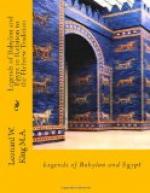(1) The remains that are preserved of the determinative, which is not combined with the sign EN, proves that Enki’s name is not to be restored. Hence Ziusudu was not priest of Enki, and his city was probably not Eridu, the seat of his divine friend and counsellor, and the first of the Antediluvian cities. Sufficient reason for Enki’s intervention on Ziusudu’s behalf is furnished by the fact that, as God of the Deep, he was concerned in the proposed method of man’s destruction. His rivalry of Enlil, the God of the Earth, is implied in the Babylonian Version (cf. Gilg. Epic. XI, ll. 39-42), and in the Sumerian Version this would naturally extend to Anu, the God of Heaven.
The employment of the royal title by itself accords with the tradition from Berossus that before the Deluge, as in later periods, the land was governed by a succession of supreme rulers, and that the hero of the Deluge was the last of them. In the Gilgamesh Epic, on the other hand, Ut-napishtim is given no royal nor any other title. He is merely referred to as a “man of Shuruppak, son of Ubar-Tutu”, and he appears in the guise of an ancient hero or patriarch not invested with royal power. On this point Berossus evidently preserves the original Sumerian traditions, while the Hebrew Versions resemble the Semitic-Babylonian narrative. The Sumerian conception of a series of supreme Antediluvian rulers is of course merely a reflection from the historical period, when the hegemony in Babylonia was contested among the city-states. The growth of the tradition may have been encouraged by the early use of lugal, “king”, which, though always a term of secular character, was not very sharply distinguished from that of patesi and other religious titles, until, in accordance with political development, it was required to connote a wider dominion. In Sumer, at the time of the composition of our text, Ziusudu was still only one in a long line of Babylonian rulers, mainly historical but gradually receding into the realms of legend and myth. At the time of the later Semites there had been more than one complete break in the tradition and the historical setting of the old story had become dim. The fact that Hebrew tradition should range itself in this matter with Babylon rather than with Sumer is important as a clue in tracing the literary history of our texts.




